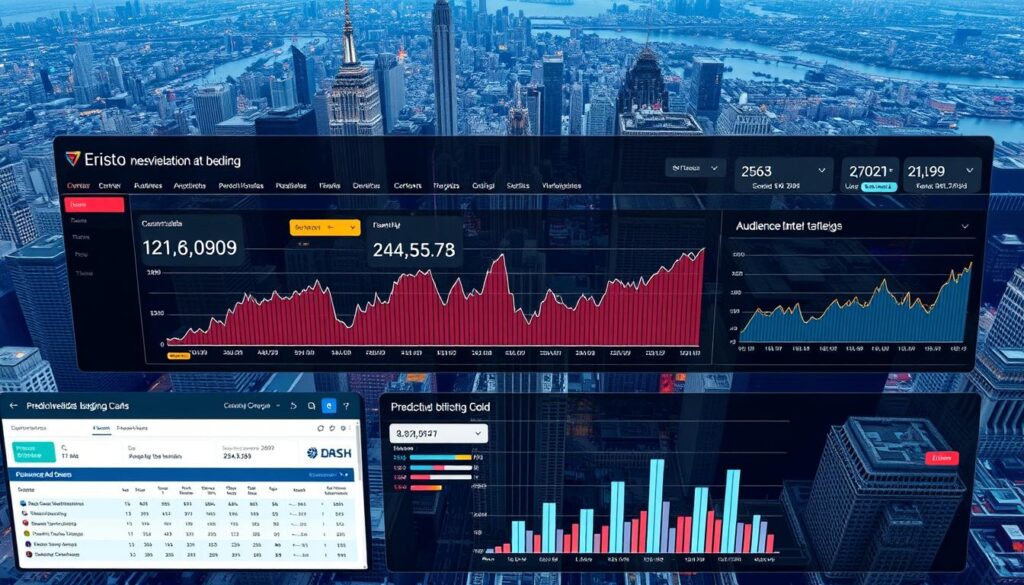65% of large marketing budgets go toward impressions that never reach high-value customers. That wasted spend is a silent growth tax for premium brands.
We build a modern operating system for advertising that reclaims that value. By turning data into real-time decisions, we cut waste and raise measurable performance across media.
Our systems read shopper signals at scale—likelihood to engage, convert, and expected spend—and place the right bid in roughly 10 milliseconds. The result is ads seen by the audiences that matter and sales that move the needle.
We partner with high-ticket businesses that demand transparency and ROI. Expect clear governance, forecasting, and controls that protect brand value while accelerating growth.
Ready to stop guessing and start scaling? Request a consultation and a Growth Blueprint to see how we translate data into repeatable business outcomes.
Key Takeaways
- Most budgets leak value; targeted systems reclaim spend for higher returns.
- We use commerce signals and fast decisioning to improve performance and sales.
- Our approach prioritizes transparency, controls, and measurable business value.
- Short-term wins and long-term compound growth come from disciplined data-to-decision flows.
- Consultations and a Growth Blueprint show the path to scalable ROI for premium brands.
The present-day imperative: Stop leaking budget, start scaling profitable performance
Every dollar that leaks from your marketing plan compounds into lost market share and slower growth. What’s holding back teams today is not ambition but the systems they use.
Manual cycles, lagging dashboards, and fragmented channel tools create a gap between intent and impact. These frictions let budgets drift to low-value placements and mute the lift in sales.
What’s holding back high-growth brands from 10X ROI today
We surface the key constraints: slow decision loops, siloed media reports, and rulebooks that can’t react to auction trends. Human timing fails where milliseconds decide outcomes.
From manual bids to machine learning: the shift performance media demands now
Leading systems ingest granular commerce signals—engagement propensity, conversion likelihood, expected spend—and act per impression in sub-blink timing. That change moves spend from guesses to measured outcomes aligned with revenue and profit goals.
- Fewer wasted impressions: tighter allocation to high-value inventory.
- Faster participation: better auction placement when publisher trends favor your brand.
- Governed scale: rules and oversight that protect brand value as the system compounds growth.
What is Automated / Predictive Ad Bidding and why it matters for revenue, not just clicks
We turn impression-level signals into price decisions that drive revenue, not just views.
Predictive bidding calculates the optimal bid for every impression using shopper signals: likelihood to engage, conversion probability, and expected spend. Decisions execute in real time and select inventory by predicted publisher performance.

This approach shifts focus from clicks to value. Algorithms weigh conversion chance, basket size, and product margin so bids favor higher-return placements. The result is spend concentrated where it compounds sales and profit.
From “best guess” to “calculates optimal bid” for every impression
We replace averages with decisioning that estimates the optimal bid per impression. That means fewer low-yield impressions and more budget on high-propensity shoppers.
Optimizing to business value: ROAS, CPA, profit, and product margin
Optimize to business goals by folding conversion value and margin into every bid. Reporting then ties each dollar of spend to revenue, profitability, and pipeline quality—not vanity metrics.
| Signal | What it predicts | Business action | Outcome |
|---|---|---|---|
| Engagement recency | Likelihood to click | Raise bid for warm prospects | Higher conversion rate |
| Expected basket value | Revenue per conversion | Prioritize high-margin product ads | Improved profit per sale |
| Publisher trend score | Inventory quality | Shift spend to top-performing placements | Lower wasted spend |
How Macro Webber’s approach works: data, models, and decisions in milliseconds
Macro Webber converts raw commerce signals into millisecond decisions that drive measurable revenue.
We fuse first-party and media telemetry to score each impression for engagement, conversion likelihood, and expected spend. Models run feature sets that reflect margin, stock status, and pacing so outcomes respect business constraints.
Commerce AI signals: engagement, conversion likelihood, and expected spend
Signals feed models that estimate value per impression. We use high-resolution data on shopper intent and historical behavior to calculate the optimal bid for each opportunity.
Real-time decisions at the right time: bids placed in ~10 milliseconds
Decisions execute at auction speed so you win the impressions that matter without latency loss. Our runtime both places bids and applies safeguards that temper aggressiveness during volatility.
Selecting inventory based on publisher performance trends
We choose placements using based predicted publisher performance. The system steers delivery to inventory where historical and emergent signals show superior conversion and ROI.
“We make every impression accountable to revenue and margin.”
- Integrate data to compute per-impression value.
- Act in ~10 milliseconds to secure high-return opportunities.
- Align model features to business rules for safe adjustments.
- Continuously retrain to capture seasonality and media shifts.
| Signal | Predicts | Action | Outcome |
|---|---|---|---|
| Engagement score | Click and browse intent | Raise or lower bids | Better conversion rate |
| Expected spend | Revenue per conversion | Prioritize high-margin inventory | Higher profit per sale |
| Publisher trend | Supply quality | Shift to top placements | Reduced wasted media |
Our approach gives transparent rules and metrics so you see how the system calculates optimal bid, when it adapts, and why inventory is prioritized. This clarity turns models into predictable performance for premium brands.
Predictive bidding across platforms your buyers actually use
Our system unites search, retail, and social channels so one strategy governs where customers shop and convert.

Amazon and Walmart: ensuring your ads are seen by the right audience
On marketplaces where intent is highest, we apply a marketplace-aware layer that targets product listings and keywords. This ensures your ads are seen at the right time and that spend flows to listings that drive sales.
Search, social, and retail media: unified performance across publishers
We normalize signals across platforms to avoid double-counting and internal competition. That unified view keeps campaigns aligned with product objectives and prevents overlapping bids that dilute volume.
- Orchestrate media across Amazon, Walmart, search, social, and retail channels to concentrate spend where performance scales.
- Coordinate bids so campaigns do not compete on the same keywords or customer segments.
- Transparent reporting shows which publishers deliver incremental customers and where sales originate.
The result: one system of record, cleaner operations, and more time for strategy and creative that moves the needle.
Align bids to your business goals, not platform proxies
Strategy must map every dollar of media to a clear business outcome, not a platform metric.
We design strategy groups tied to efficiency, volume, engagement, or awareness so the system calculates optimal bid for each objective. This keeps campaigns focused on revenue, not vanity signals.
Strategies for efficiency, volume, engagement, and awareness
We translate business goals into target measurements: ROAS or CPA for efficiency, clicks for volume, page views for engagement, and impression share for awareness.
Rules and previews let teams approve large adjustments and keep pacing, margin, and risk constraints intact.
Campaign performance mapped to spend, conversions, and impression share goals
- We align campaigns to the right metric so optimization reflects how your brand wins in market.
- Guardrails limit abrupt bid changes and preserve predictable spend and margin.
- Central governance reduces holding back forces like proxy KPIs and siloed channel rules.
| Objective | Primary Measure | How we act | Control |
|---|---|---|---|
| Efficiency | ROAS / CPA | System calculates optimal bid to favor high-value conversions | Margin and pacing caps |
| Volume | Clicks / Conversions | Raise bids for scale when ROI meets thresholds | Daily spend ceilings |
| Engagement | Page views / Time on site | Prioritize placements that drive deeper sessions | Preview and approve shifts |
| Awareness | Impression share | Allocate budget to reach targets across publishers | Frequency and brand-safe rules |
Turn data into growth: CLV, offline conversions, and full-funnel optimization
We convert offline sales and call records into actionable signals that sharpen campaign returns.
Customer lifetime value anchors every decision. We fold lifetime value into models so acquisition and retention runs optimize for long-term margin, not short-term clicks.
Customer lifetime and funnel stages
We map funnel stages and weight first purchase differently than repeat behavior. That distinction lets us favor segments that compound value over time.
Call tracking and offline conversions
Call tracking and POS sales feed back into the system. This closes attribution gaps so bid changes reflect actual sales and not online proxies.
“End-to-end signals turn vague performance into clear enterprise outcomes.”
- We incorporate CLV to reflect true profitability of new versus existing customers.
- We audit data coverage and latency to preserve signal integrity.
- Leadership reports tie spend to revenue, margin, and cohort lifetime value.
| Signal | Predicts | Action | Outcome |
|---|---|---|---|
| Call tracking | Attributed offline sales | Adjust spend for high-value leads | Improved sales accuracy |
| Repeat purchases | Customer lifetime patterns | Shift budget to retention media | Higher lifetime value |
| Upper-funnel signals | Awareness to interest | Sequence creative then convert | Better campaign performance |
Our approach blends media sequencing and rich data so advertising drives measurable sales and scalable growth.
Faster than a blink: speed, scale, and the “right time” advantage
Speed turns moments into market share. We act in roughly 10 milliseconds so decisions land at the right time and convert intent into sales.
We scale decisioning across millions of auctions without losing governance. That means teams keep control while models improve performance and compound return.
We save time for your people by removing repetitive tasks. Teams focus on strategy, creative, and partnerships instead of manual tuning.
- Make bids in milliseconds to capture fleeting intent and measurable sales.
- Adapt within-day as data shifts so media follows demand spikes.
- Engineered pipelines deliver low latency feedback so models iterate quickly.
- Guardrails limit variance, protecting margin and pacing.
- Transparent logs and dashboards show when bids changed and why.
We unify speed with precision so rapid reactions become durable advantages—not volatility. Leaders get fast results with stability and enterprise-grade accountability.
Forecasting your next level: budget scenarios, seasonality, and market shifts
We model future spend scenarios so leadership can see returns before committing capital.
Transparent forecasts let teams visualize clicks, cost, conversions, profit, and gross profit at each spend level. That clarity reduces risk and aligns budgets to commercial goals.
Our models run scenarios that show marginal efficiency and ceiling dynamics. Executives can compare outcomes and approve moves with confidence.
Visualizing returns at different spend levels before you commit
We present clear charts and tables so you can test how incremental spend affects sales and profit. Each scenario includes sensitivity to trends and competitive shifts.
Dayparting and seasonality: from weekly patterns to major promotions
We apply dayparting and weekly adjustments so delivery matches demand curves. This protects profitability across routine peaks and large promotions.
Proactive boosts for sales events and rapidly changing conversion values
We schedule promotional boosts and automate rapid adjustments when conversion value changes. That reduces wasted media and captures short-lived opportunity.
“Forecasting turns uncertainty into an executable budget with guardrails.”
- Scenario modeling visualizes returns at different spend levels before you commit.
- We tune for trends and seasonality using dayparting and weekly patterns.
- Promotional boosts are scheduled and risk-limited to protect post-event pacing.
- Systems ingest contextual data—inventory, SEO visibility, and competitive signals—to refine strategy.
Transparency, control, and trust: see, preview, and override when it counts
Stakeholders demand systems that explain every adjustment and let them step in when it matters most. We give teams preview tools, clear rules, and manual controls so enterprise leaders retain oversight without slowing growth.
Preview bids and constrain changes with rules
Preview modes let stakeholders QA proposed bids before activation. Teams can simulate outcomes and approve bulk adjustments that align with compliance and expected value.
Manual overrides and clean-data safeguards
Owners can override the calculated bid for critical keywords and lock settings for time-bound campaigns. We also exclude anomalous dates so corrupted inputs do not skew future decisions.
Dynamic actions and contextual signals
Dynamic actions factor in contextual data such as inventory levels, SEO trends, weather, and macro signals. This keeps advertising calibrated to reality and improves real-time adjustments.
“We balance scale with governance so every change is visible, auditable, and reversible.”
| Control | Action | Outcome |
|---|---|---|
| Preview | Simulate proposed bids | Policy-aligned activations |
| Overrides | Lock keywords or manual bid | Protect critical value drivers |
| Dynamic rules | Apply inventory & SEO signals | Context-aware adjustments |
Implementation with Macro Webber: from data onboarding to measurable lift
We prioritize day-one accuracy so campaigns drive revenue from the first cycle. Our rollout is executive-friendly: clear milestones, measurable checkpoints, and governance built into every stage.
Historical data ingestion for day-one accuracy
We ingest up to 12 months of historical data to calibrate models fast. This reduces ramp time and ensures relevance to product categories and customer lifetime patterns.
Coordinating multiple brands and avoiding internal bid collisions
We coordinate brand portfolios to prevent internal competition and preserve margin. Central rules map keywords and campaign boundaries so teams share visibility without fighting for the same spend.
Proof of impact: increase sales, save time, and scale campaigns with confidence
We integrate CLV, call tracking, and offline conversions so decisions reflect true revenue, not proxies. Scheduled actions manage promotions and seasonality.
- Day-one accuracy: calibrated from historical signals.
- Multi-brand governance: keyword and spend controls to avoid collisions.
- Measurable outcomes: increase sales, higher efficiency, and tangible time savings for teams.
“We link advertising to revenue and cohort growth so leaders can approve scale with confidence.”
Conclusion
When strategy, speed, and governance align, spend becomes a predictable engine for growth. We turn advertising into measurable revenue by selecting winning inventory, reacting at sub-blink speed, and forecasting outcomes across budget levels.
Our approach ties every decision to business goals so product conversion and campaign performance drive real sales and margin. Transparency, preview controls, and manual overrides keep you in command as optimization compounds returns.
Move now to secure the early advantage. Book a Growth Blueprint with Macro Webber today to increase sales, compress ramp time, and unlock level‑up performance before competitors capture the right time moments.



